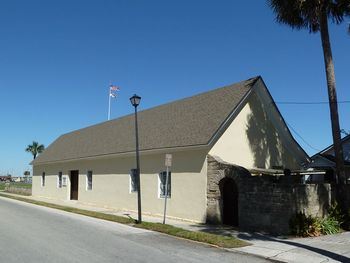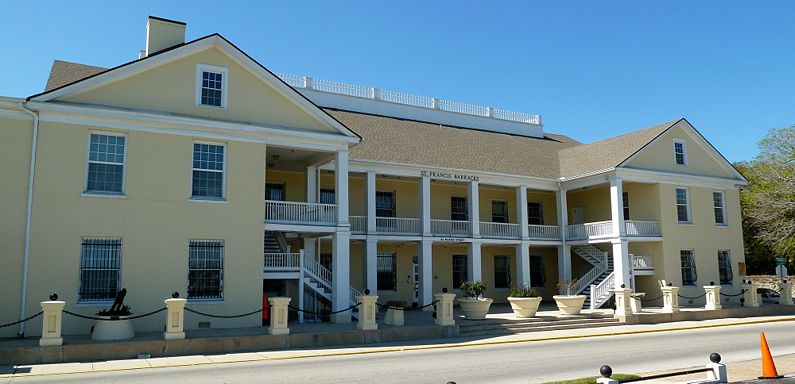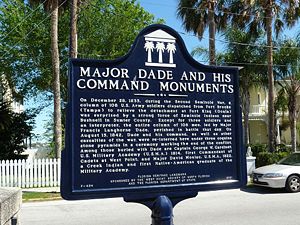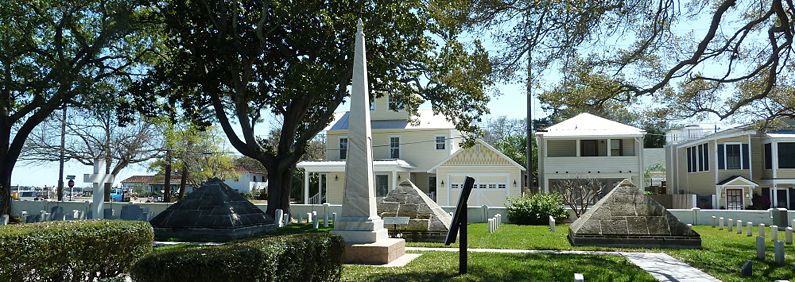St. Francis Barracks
|
St. Francis Barracks (1765-1900, 1907-Present) - First established as a military barracks in 1765 by British forces in present day St. Augustine, St. Johns County, Florida. Active Florida National Guard post. Named for St. Francis in 1881. Also known as State Arsenal and St. Augustine Arsenal.
Early HistoryThe original structure began as part of the chapel and convent of Convento de San Francisco established by Spanish Franciscan missionaries in 1588. The Convento de San Francisco buildings were rebuilt with coquina walls after 1702 after several fires and conflicts destroyed the wooden structures. British Period (1763 - 1783)In the Treaty of Paris (1763) the Spanish ceded Florida to the British. During the British occupation of Florida between 1763 and 1783 the existing buildings were converted to military use and several additional buildings were constructed, one of which, the Kings Bakery, has survived and been restored. The British used the barracks to house the garrison for the nearby Fort St. Mark (Castillo de San Marcos under Spanish rule). Second Spanish Period (1783-1821)With the Treaty of Paris (1783) control of Florida returned to the Spanish. The barracks was also used by the Spanish to house the garrison for the renamed Castillo de San Marcos. U.S. Period (1821-1900)The Adams-Onis Treaty (ratified in 1821) gave control of Florida to the United States and the Castillo de San Marcos was renamed as Fort Marion (1) in 1825. The first use of the newly acquired buildings of the barracks was as a jail. In 1832, Congress set aside the barracks land as a military reservation. Second Seminole War (1835-1842)The Second Seminole War began on Christmas day 1835 with the massacre of 107 officers and men under the command of Major Francis L. Dade by hostile Seminole Indians. It was during the Second Seminole War that the south end garden of the reservation came into general use as a post cemetery. At the end of the conflict in 1842, a solemn ceremony took place that moved the remains of the officers and men of Dade's massacred command from the site of the massacre to the post cemetery at the barracks garden. The remains of Dade's command and eventually some 1468 officers and men killed in the Second Seminole War were interred in vaults under three coquina stone pyramids that remain there today in what became the St. Augustine National Cemetery in 1881. U.S. Civil War (1861-1865)The Barracks was not garrisoned at the beginning of the U.S. Civil War and only a single caretaker ordnance sergeant was present when local militia troops demanded that the caretaker surrender both the St. Francis Barracks and nearby Fort Marion (1). The sergeant surrendered the keys to both facilities and received a receipt for them. Fort Marion (1) and St. Francis Barracks were returned to Union hands when St. Augustine was taken back by Union forces on 11 Mar 1862. After the war, in 1867, the barracks were refurbished and suites were provided for the officers. In 1881, the title "St. Francis Barracks" came into use while the 5th U.S. Artillery garrisoned the post. Separate officer quarters were built in the early 1880s while the post was under the command of Bvt. Brigadier General Frederick T. Dent who was a friend and brother-in-law to then President Ulysses S. Grant. The U.S. Army abandoned the post in 1900 and leased the property to the State of Florida on 15 Aug 1907. On 13 Dec 1915, a fire destroyed the upper floor of the old barracks building. It was rebuilt in 1921 and the property was donated to the State of Florida for use by the Military Department of the State. Current Status
Currently the Florida Military Department Headquarters and the St. Augustine National Cemetery in St. Augustine, St. Johns County, Florida. The post contains historical buildings dating back to the British era including the restored barracks building and the restored Kings Bakery building. Also present are restored officer quarters buildings from the 1880s and more modern periods. All of these buildings are currently in use. A significant part of the reservation is now the St. Augustine National Cemetery which is small by national cemetery standards but very historic. The cemetery contains the remains of the officers and men killed in the 1835 Dade Massacre that signaled the start of the Second Seminole War. All of the Dade Massacre victims are interred under three coquina rock pyramids with a marble monument to all the casualties of the Seminole Wars. The vaults under the three pyramids contain the individually unidentified remains of 1468 officers and men killed in the Second Seminole War including the Dade Massacre victims.
Sources:
Links:
Visited: 5 Mar 2012
| ||||||||||





